English Composition: Tertiary Sector and Poverty in India Essay
VerifiedAdded on 2023/04/21
|5
|1470
|333
Essay
AI Summary
This essay critically examines the role of citation and cross-references in academic writing, particularly within the context of India's tertiary sector and its impact on poverty reduction. The essay analyzes two key articles: one by Mitra and Schmid, which explores the potential of the tertiary sector to alleviate poverty through economic growth, and another by Datt and Ravallion, which focuses on the effects of agricultural productivity on rural poverty. The analysis emphasizes how the articles cite and build upon each other to support their arguments, highlighting the importance of referencing other scholarly works to strengthen claims and provide a comprehensive view of the subject. The essay concludes by underscoring the necessity of citation in academic research to avoid plagiarism and demonstrate a thorough understanding of existing literature, using the two articles as examples of how citations enhance research projects and validate findings. The assignment aims to show how the growth in tertiary sector is proportional to poverty reduction and overall economic growth in India and how agricultural growth affects the lives of people in rural areas.
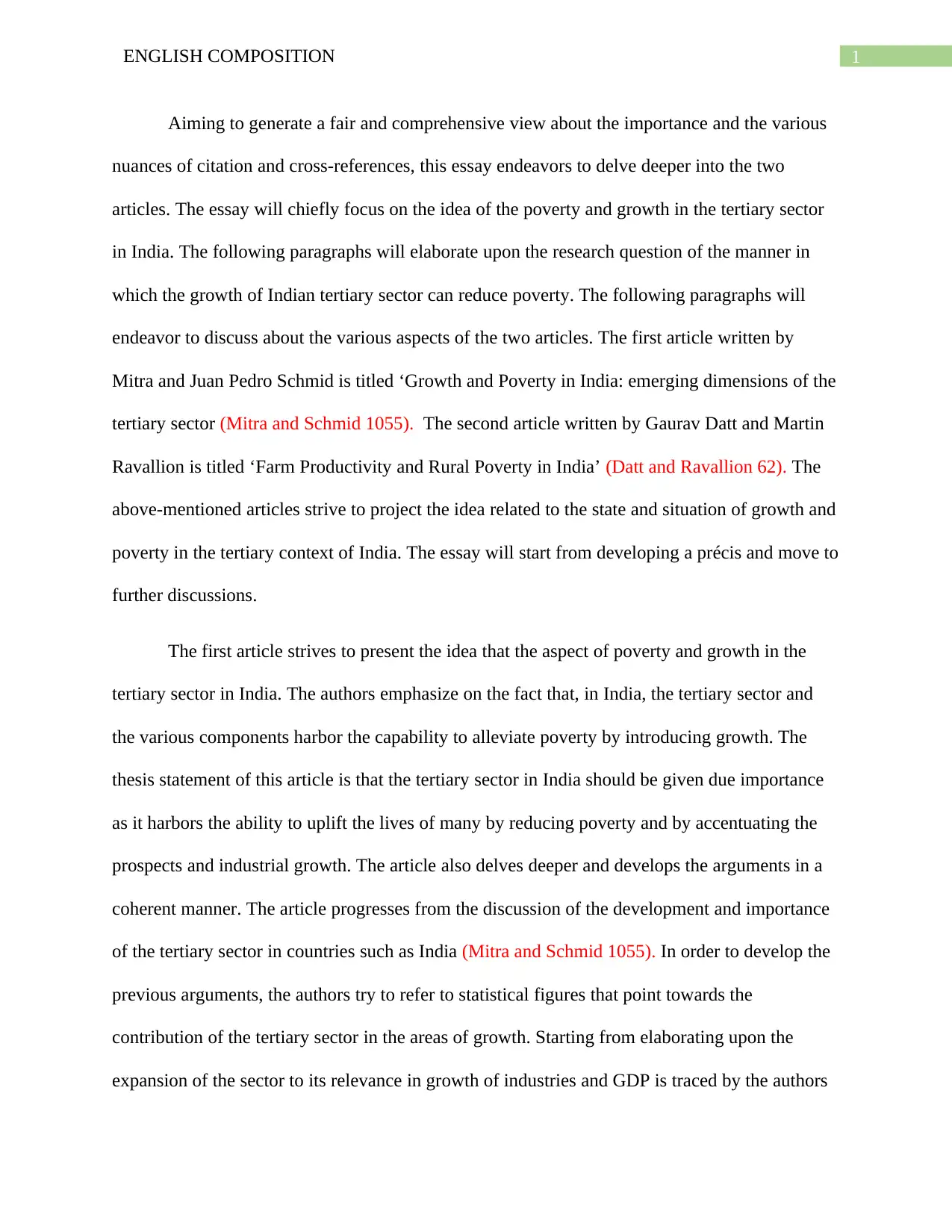
1ENGLISH COMPOSITION
Aiming to generate a fair and comprehensive view about the importance and the various
nuances of citation and cross-references, this essay endeavors to delve deeper into the two
articles. The essay will chiefly focus on the idea of the poverty and growth in the tertiary sector
in India. The following paragraphs will elaborate upon the research question of the manner in
which the growth of Indian tertiary sector can reduce poverty. The following paragraphs will
endeavor to discuss about the various aspects of the two articles. The first article written by
Mitra and Juan Pedro Schmid is titled ‘Growth and Poverty in India: emerging dimensions of the
tertiary sector (Mitra and Schmid 1055). The second article written by Gaurav Datt and Martin
Ravallion is titled ‘Farm Productivity and Rural Poverty in India’ (Datt and Ravallion 62). The
above-mentioned articles strive to project the idea related to the state and situation of growth and
poverty in the tertiary context of India. The essay will start from developing a précis and move to
further discussions.
The first article strives to present the idea that the aspect of poverty and growth in the
tertiary sector in India. The authors emphasize on the fact that, in India, the tertiary sector and
the various components harbor the capability to alleviate poverty by introducing growth. The
thesis statement of this article is that the tertiary sector in India should be given due importance
as it harbors the ability to uplift the lives of many by reducing poverty and by accentuating the
prospects and industrial growth. The article also delves deeper and develops the arguments in a
coherent manner. The article progresses from the discussion of the development and importance
of the tertiary sector in countries such as India (Mitra and Schmid 1055). In order to develop the
previous arguments, the authors try to refer to statistical figures that point towards the
contribution of the tertiary sector in the areas of growth. Starting from elaborating upon the
expansion of the sector to its relevance in growth of industries and GDP is traced by the authors
Aiming to generate a fair and comprehensive view about the importance and the various
nuances of citation and cross-references, this essay endeavors to delve deeper into the two
articles. The essay will chiefly focus on the idea of the poverty and growth in the tertiary sector
in India. The following paragraphs will elaborate upon the research question of the manner in
which the growth of Indian tertiary sector can reduce poverty. The following paragraphs will
endeavor to discuss about the various aspects of the two articles. The first article written by
Mitra and Juan Pedro Schmid is titled ‘Growth and Poverty in India: emerging dimensions of the
tertiary sector (Mitra and Schmid 1055). The second article written by Gaurav Datt and Martin
Ravallion is titled ‘Farm Productivity and Rural Poverty in India’ (Datt and Ravallion 62). The
above-mentioned articles strive to project the idea related to the state and situation of growth and
poverty in the tertiary context of India. The essay will start from developing a précis and move to
further discussions.
The first article strives to present the idea that the aspect of poverty and growth in the
tertiary sector in India. The authors emphasize on the fact that, in India, the tertiary sector and
the various components harbor the capability to alleviate poverty by introducing growth. The
thesis statement of this article is that the tertiary sector in India should be given due importance
as it harbors the ability to uplift the lives of many by reducing poverty and by accentuating the
prospects and industrial growth. The article also delves deeper and develops the arguments in a
coherent manner. The article progresses from the discussion of the development and importance
of the tertiary sector in countries such as India (Mitra and Schmid 1055). In order to develop the
previous arguments, the authors try to refer to statistical figures that point towards the
contribution of the tertiary sector in the areas of growth. Starting from elaborating upon the
expansion of the sector to its relevance in growth of industries and GDP is traced by the authors
Paraphrase This Document
Need a fresh take? Get an instant paraphrase of this document with our AI Paraphraser
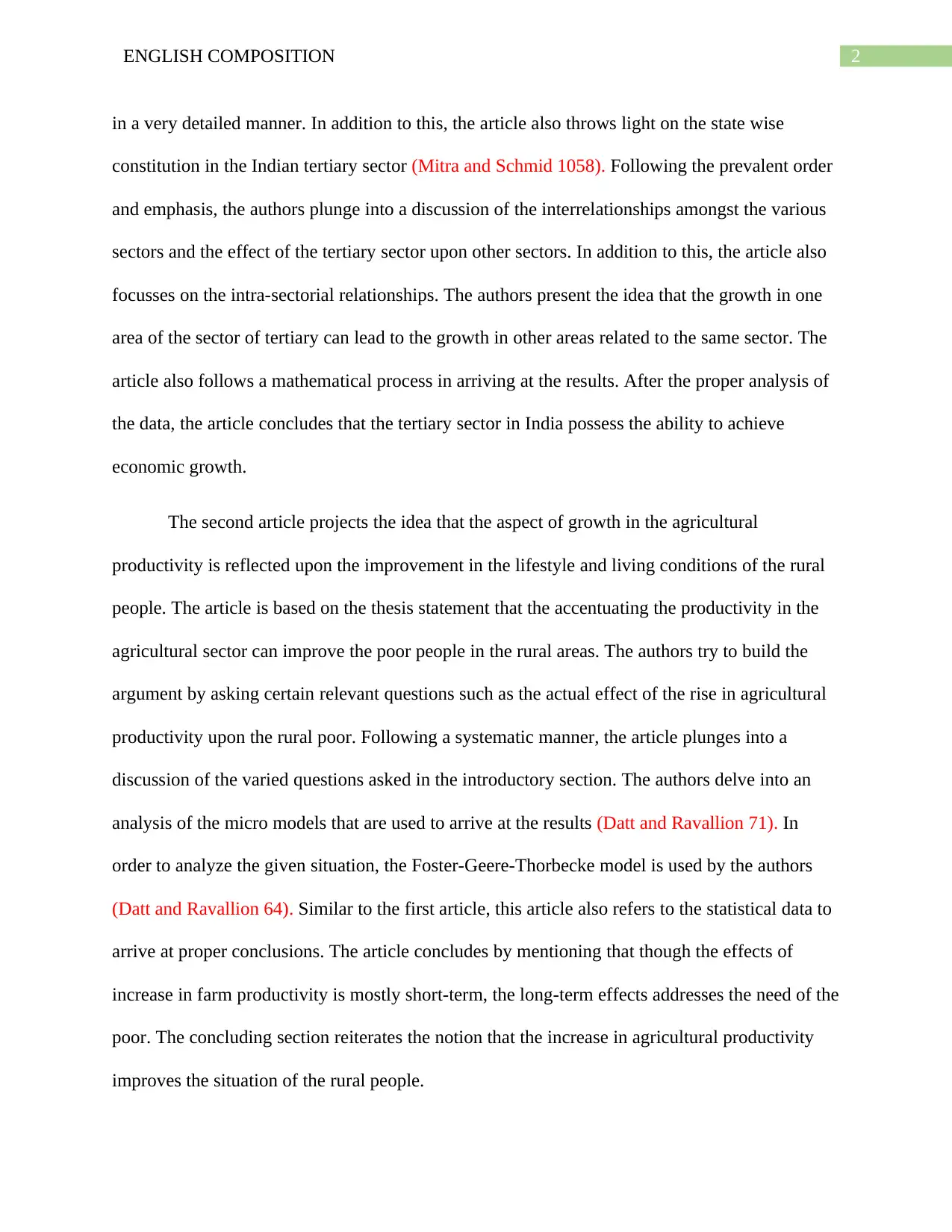
2ENGLISH COMPOSITION
in a very detailed manner. In addition to this, the article also throws light on the state wise
constitution in the Indian tertiary sector (Mitra and Schmid 1058). Following the prevalent order
and emphasis, the authors plunge into a discussion of the interrelationships amongst the various
sectors and the effect of the tertiary sector upon other sectors. In addition to this, the article also
focusses on the intra-sectorial relationships. The authors present the idea that the growth in one
area of the sector of tertiary can lead to the growth in other areas related to the same sector. The
article also follows a mathematical process in arriving at the results. After the proper analysis of
the data, the article concludes that the tertiary sector in India possess the ability to achieve
economic growth.
The second article projects the idea that the aspect of growth in the agricultural
productivity is reflected upon the improvement in the lifestyle and living conditions of the rural
people. The article is based on the thesis statement that the accentuating the productivity in the
agricultural sector can improve the poor people in the rural areas. The authors try to build the
argument by asking certain relevant questions such as the actual effect of the rise in agricultural
productivity upon the rural poor. Following a systematic manner, the article plunges into a
discussion of the varied questions asked in the introductory section. The authors delve into an
analysis of the micro models that are used to arrive at the results (Datt and Ravallion 71). In
order to analyze the given situation, the Foster-Geere-Thorbecke model is used by the authors
(Datt and Ravallion 64). Similar to the first article, this article also refers to the statistical data to
arrive at proper conclusions. The article concludes by mentioning that though the effects of
increase in farm productivity is mostly short-term, the long-term effects addresses the need of the
poor. The concluding section reiterates the notion that the increase in agricultural productivity
improves the situation of the rural people.
in a very detailed manner. In addition to this, the article also throws light on the state wise
constitution in the Indian tertiary sector (Mitra and Schmid 1058). Following the prevalent order
and emphasis, the authors plunge into a discussion of the interrelationships amongst the various
sectors and the effect of the tertiary sector upon other sectors. In addition to this, the article also
focusses on the intra-sectorial relationships. The authors present the idea that the growth in one
area of the sector of tertiary can lead to the growth in other areas related to the same sector. The
article also follows a mathematical process in arriving at the results. After the proper analysis of
the data, the article concludes that the tertiary sector in India possess the ability to achieve
economic growth.
The second article projects the idea that the aspect of growth in the agricultural
productivity is reflected upon the improvement in the lifestyle and living conditions of the rural
people. The article is based on the thesis statement that the accentuating the productivity in the
agricultural sector can improve the poor people in the rural areas. The authors try to build the
argument by asking certain relevant questions such as the actual effect of the rise in agricultural
productivity upon the rural poor. Following a systematic manner, the article plunges into a
discussion of the varied questions asked in the introductory section. The authors delve into an
analysis of the micro models that are used to arrive at the results (Datt and Ravallion 71). In
order to analyze the given situation, the Foster-Geere-Thorbecke model is used by the authors
(Datt and Ravallion 64). Similar to the first article, this article also refers to the statistical data to
arrive at proper conclusions. The article concludes by mentioning that though the effects of
increase in farm productivity is mostly short-term, the long-term effects addresses the need of the
poor. The concluding section reiterates the notion that the increase in agricultural productivity
improves the situation of the rural people.
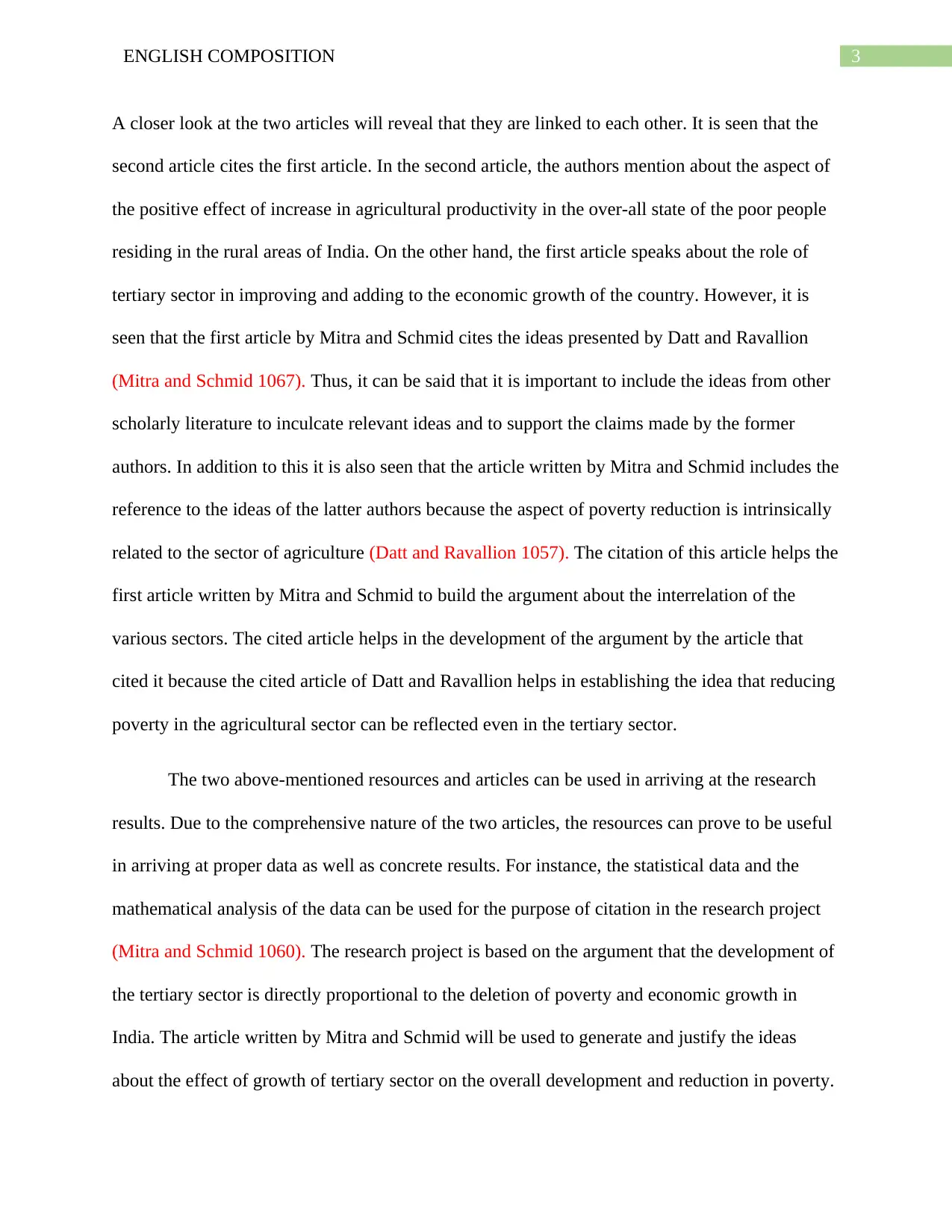
3ENGLISH COMPOSITION
A closer look at the two articles will reveal that they are linked to each other. It is seen that the
second article cites the first article. In the second article, the authors mention about the aspect of
the positive effect of increase in agricultural productivity in the over-all state of the poor people
residing in the rural areas of India. On the other hand, the first article speaks about the role of
tertiary sector in improving and adding to the economic growth of the country. However, it is
seen that the first article by Mitra and Schmid cites the ideas presented by Datt and Ravallion
(Mitra and Schmid 1067). Thus, it can be said that it is important to include the ideas from other
scholarly literature to inculcate relevant ideas and to support the claims made by the former
authors. In addition to this it is also seen that the article written by Mitra and Schmid includes the
reference to the ideas of the latter authors because the aspect of poverty reduction is intrinsically
related to the sector of agriculture (Datt and Ravallion 1057). The citation of this article helps the
first article written by Mitra and Schmid to build the argument about the interrelation of the
various sectors. The cited article helps in the development of the argument by the article that
cited it because the cited article of Datt and Ravallion helps in establishing the idea that reducing
poverty in the agricultural sector can be reflected even in the tertiary sector.
The two above-mentioned resources and articles can be used in arriving at the research
results. Due to the comprehensive nature of the two articles, the resources can prove to be useful
in arriving at proper data as well as concrete results. For instance, the statistical data and the
mathematical analysis of the data can be used for the purpose of citation in the research project
(Mitra and Schmid 1060). The research project is based on the argument that the development of
the tertiary sector is directly proportional to the deletion of poverty and economic growth in
India. The article written by Mitra and Schmid will be used to generate and justify the ideas
about the effect of growth of tertiary sector on the overall development and reduction in poverty.
A closer look at the two articles will reveal that they are linked to each other. It is seen that the
second article cites the first article. In the second article, the authors mention about the aspect of
the positive effect of increase in agricultural productivity in the over-all state of the poor people
residing in the rural areas of India. On the other hand, the first article speaks about the role of
tertiary sector in improving and adding to the economic growth of the country. However, it is
seen that the first article by Mitra and Schmid cites the ideas presented by Datt and Ravallion
(Mitra and Schmid 1067). Thus, it can be said that it is important to include the ideas from other
scholarly literature to inculcate relevant ideas and to support the claims made by the former
authors. In addition to this it is also seen that the article written by Mitra and Schmid includes the
reference to the ideas of the latter authors because the aspect of poverty reduction is intrinsically
related to the sector of agriculture (Datt and Ravallion 1057). The citation of this article helps the
first article written by Mitra and Schmid to build the argument about the interrelation of the
various sectors. The cited article helps in the development of the argument by the article that
cited it because the cited article of Datt and Ravallion helps in establishing the idea that reducing
poverty in the agricultural sector can be reflected even in the tertiary sector.
The two above-mentioned resources and articles can be used in arriving at the research
results. Due to the comprehensive nature of the two articles, the resources can prove to be useful
in arriving at proper data as well as concrete results. For instance, the statistical data and the
mathematical analysis of the data can be used for the purpose of citation in the research project
(Mitra and Schmid 1060). The research project is based on the argument that the development of
the tertiary sector is directly proportional to the deletion of poverty and economic growth in
India. The article written by Mitra and Schmid will be used to generate and justify the ideas
about the effect of growth of tertiary sector on the overall development and reduction in poverty.
⊘ This is a preview!⊘
Do you want full access?
Subscribe today to unlock all pages.

Trusted by 1+ million students worldwide
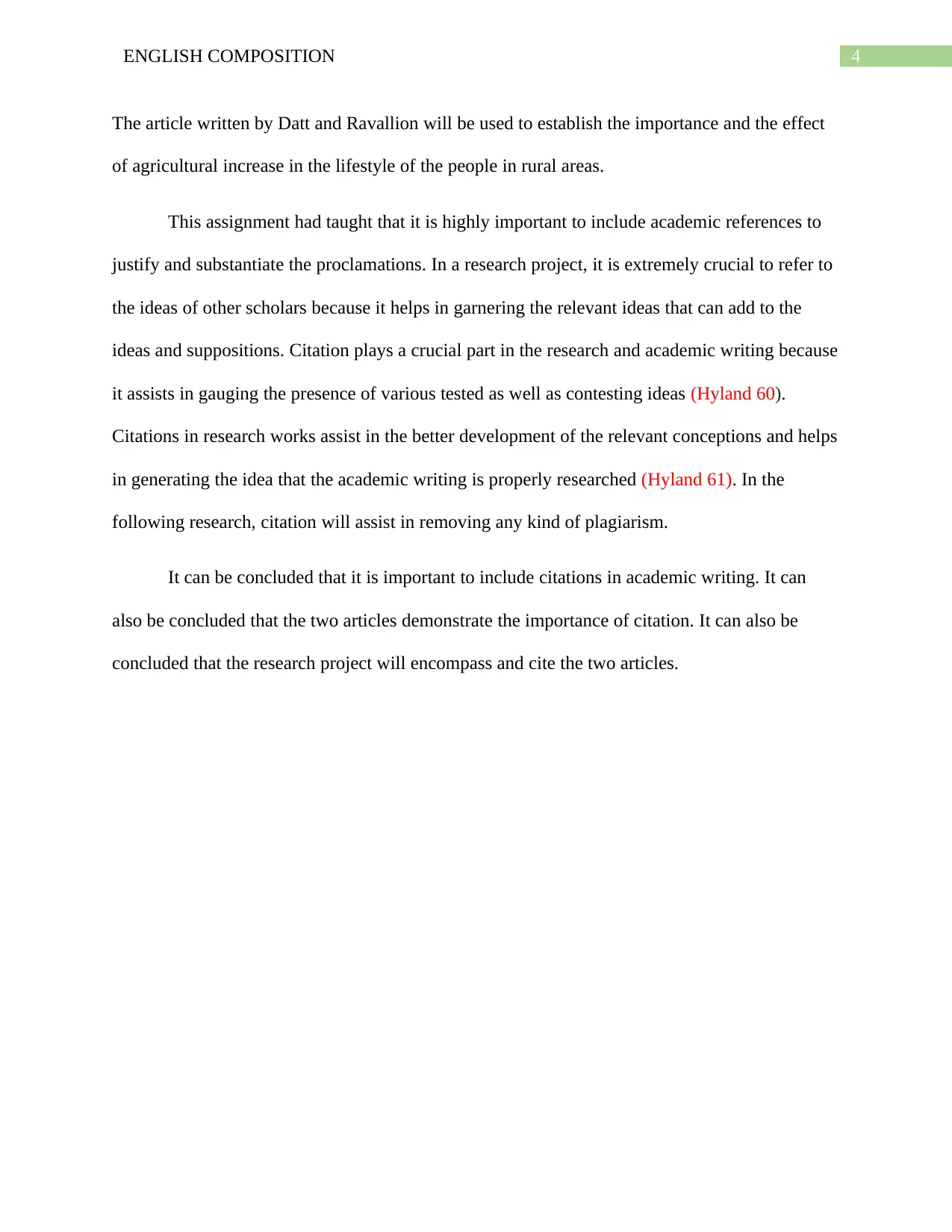
4ENGLISH COMPOSITION
The article written by Datt and Ravallion will be used to establish the importance and the effect
of agricultural increase in the lifestyle of the people in rural areas.
This assignment had taught that it is highly important to include academic references to
justify and substantiate the proclamations. In a research project, it is extremely crucial to refer to
the ideas of other scholars because it helps in garnering the relevant ideas that can add to the
ideas and suppositions. Citation plays a crucial part in the research and academic writing because
it assists in gauging the presence of various tested as well as contesting ideas (Hyland 60).
Citations in research works assist in the better development of the relevant conceptions and helps
in generating the idea that the academic writing is properly researched (Hyland 61). In the
following research, citation will assist in removing any kind of plagiarism.
It can be concluded that it is important to include citations in academic writing. It can
also be concluded that the two articles demonstrate the importance of citation. It can also be
concluded that the research project will encompass and cite the two articles.
The article written by Datt and Ravallion will be used to establish the importance and the effect
of agricultural increase in the lifestyle of the people in rural areas.
This assignment had taught that it is highly important to include academic references to
justify and substantiate the proclamations. In a research project, it is extremely crucial to refer to
the ideas of other scholars because it helps in garnering the relevant ideas that can add to the
ideas and suppositions. Citation plays a crucial part in the research and academic writing because
it assists in gauging the presence of various tested as well as contesting ideas (Hyland 60).
Citations in research works assist in the better development of the relevant conceptions and helps
in generating the idea that the academic writing is properly researched (Hyland 61). In the
following research, citation will assist in removing any kind of plagiarism.
It can be concluded that it is important to include citations in academic writing. It can
also be concluded that the two articles demonstrate the importance of citation. It can also be
concluded that the research project will encompass and cite the two articles.
Paraphrase This Document
Need a fresh take? Get an instant paraphrase of this document with our AI Paraphraser
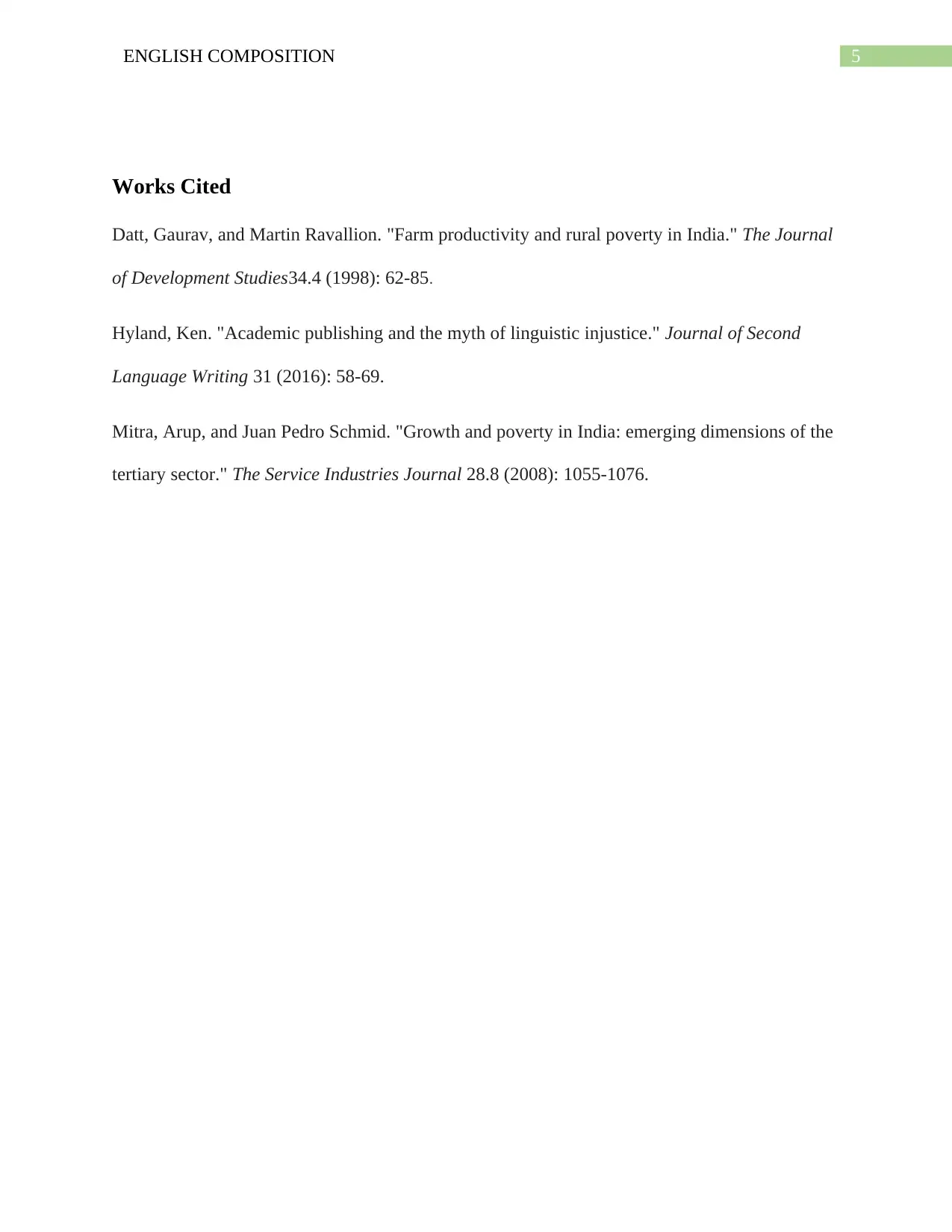
5ENGLISH COMPOSITION
Works Cited
Datt, Gaurav, and Martin Ravallion. "Farm productivity and rural poverty in India." The Journal
of Development Studies34.4 (1998): 62-85.
Hyland, Ken. "Academic publishing and the myth of linguistic injustice." Journal of Second
Language Writing 31 (2016): 58-69.
Mitra, Arup, and Juan Pedro Schmid. "Growth and poverty in India: emerging dimensions of the
tertiary sector." The Service Industries Journal 28.8 (2008): 1055-1076.
Works Cited
Datt, Gaurav, and Martin Ravallion. "Farm productivity and rural poverty in India." The Journal
of Development Studies34.4 (1998): 62-85.
Hyland, Ken. "Academic publishing and the myth of linguistic injustice." Journal of Second
Language Writing 31 (2016): 58-69.
Mitra, Arup, and Juan Pedro Schmid. "Growth and poverty in India: emerging dimensions of the
tertiary sector." The Service Industries Journal 28.8 (2008): 1055-1076.
1 out of 5
Your All-in-One AI-Powered Toolkit for Academic Success.
+13062052269
info@desklib.com
Available 24*7 on WhatsApp / Email
![[object Object]](/_next/static/media/star-bottom.7253800d.svg)
Unlock your academic potential
Copyright © 2020–2025 A2Z Services. All Rights Reserved. Developed and managed by ZUCOL.
